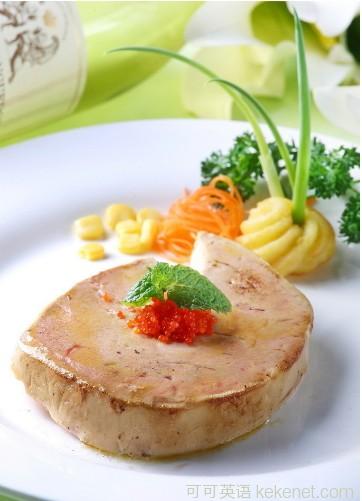(单词翻译:单击)

Science and Technolgy
科技
Foie-gras production
论鹅肝
How much is too much?
多少是个度
Why some duck livers are delicious, and others nasty
为什么有的鹅肝是珍馐,有的却让人恶心
FOIE GRAS is one of the most controversial dishes on earth. To protagonists, it is simply the finest foodstuff that exists. To those opposed, it is a product of cruelty that is not far short of criminal. The overfeeding of ducks and geese, so that their livers bloat to between six and ten times their normal size and take on a buttery consistency valued by gourmets, exploits the ability of these birds to store large amounts of calorie-rich fat, which was needed to propel them on the long migrations that their wild ancestors would routinely have undertaken. The moral argument over the way foie gras is produced (by feeding the birds with grain, through a tube or a funnel) turns on whether this is merely the permissible exaggeration of a natural inclination, or is tantamount to abuse. Intriguingly, a newly published piece of research on foie-gras production suggests the quality of the product depends on exactly the same distinction.
鹅肝是这世上最富争议的食物之一。支持鹅肝的人说它是最美的珍馐;而反对者则认为制作鹅肝与犯罪无异。鸭鹅被过度灌食后,肝脏将变为正常水平的6至10倍并呈现出美食家所推崇的黄油状,肝脏贮存脂肪的能力被充分挖掘。鸭鹅的祖先需要定期长途迁徙,而这些脂肪可以为其提供充足的能量。制作鹅肝*(用管子或漏斗对鸭鹅灌饲谷物)涉及一个道德问题:这种做法究竟是在可接受的范围内将动物自身的功能发挥至极致,还是一种虐待行为。有意思的是,最近发表的一篇关于制作鹅肝的研究认为,鹅肝的质量取决于这一问题。
From the chef's point of view, one of the disturbing things about foie gras is how variable it is. Some livers, when cooked, retain their fat and thus their rich flavour. Others lose fat when heated and end up tasting terrible. To try to work out why, Caroline Molette, a biologist at the University of Toulouse, did some experiments. Her results, just published in the Journal of Agricultural and Food Chemistry, suggest that the difference is whether the liver in question is truly healthy or not.
在厨师看来,鹅肝的麻烦事之一是质量参差不齐。有些肝脏烹饪后还保留着脂肪、油腻感十足。有些肝脏在加热后脂肪就没了,相当难吃。为了搞清楚其中缘由,法国图卢兹大学(University of Toulouse)的生物学家Caroline Molette进行了实验,并将结果发表于《农业与食品化学杂志》(Journal of Agricultural and Food Chemistry)。她认为其中差别在于所用肝脏健康与否。
Dr Molette and her colleagues raised 150 male mule ducks (a cross between Pekin and Muscovy ducks that is often used to produce foie gras) for 13 weeks in standard poultry-house conditions and then transferred them into individual enclosures. For a further 12 days the birds were fattened up with a mash of grain and flour—the usual procedure for enlarging their livers. They were then slaughtered, their livers removed, and those livers immediately trimmed of their blood vessels and chilled for six hours.
Molette博士与其同事将150只雄性杂交鸭(北京鸭与疣鼻栖鸭的杂交种,常用于生产鹅肝)在家禽饲养场标准条件下养殖13周,然后转入单独的笼子中。在之后的12天,用谷物和面粉的混合物灌饲鸭子——这是让肝脏变大的常用步骤。然后处死鸭子,取肝脏,快速剔除血管,冷藏六小时。
So far, so normal. But instead of cooking the whole things, Dr Molette removed a 200-gram sample from each liver (an average liver weighed 550 grams) and put the rest in cold storage. She then placed each sample into a jar with a bit of salt and pepper, and cooked it for an hour. As she expected, some livers released a lot of fat when cooked while others released little. Armed with this information, she was able to turn her attention back to the uncooked sections of the livers and see if she could find any systematic chemical differences between them.
到此阶段,一切正常。然而Molette 博士并没有使用整个肝脏,而是从每份肝脏(均重550克)中取200克作为样品,其余冷藏。她将每个样品分别放置在罐子中,加入少许盐和胡椒,烹饪半小时。正如她所料,烹饪时有些肝脏释放出大量脂肪,而有些却不是。获得这一信息后,她就将目光转向至还没处理的那部分肝脏,她想知道这二者之间是否存在系统性化学差异。
Using a combination of electrophoresis (which sorts proteins according to their size and electrical properties) and mass spectrometry (which sorts fragments of those proteins according to their weight), she was able to do just that. The upshot was that the fat-retaining livers were rich in a variety of proteins known to help the body digest and store food. In the fat-shedding livers, by contrast, she found high concentrations of a protein called fatty-acid-binding-protein 4. In a human liver, this would be a marker of disease. Put simply, the fat-retaining livers are healthy while the fat-shedding ones are not.
Molette 博士使用电泳(根据蛋白质的分子大小和电荷差异,将蛋白质分离)和质谱(根据分子量将蛋白碎片分离)测定来进行实验。结果发现,保留脂肪的蛋白质富含多种有助于人体消化和贮存食物的蛋白质。相比之下,她在没有脂肪的肝脏中发现了一种名为脂肪酸-结合蛋白4的蛋白质,且浓度很高。在人类肝脏中,这种蛋白是一种疾病指示物。简单的说,保留脂肪的肝脏是健康肝脏,而没有脂肪的肝脏不健康。
Both sides of the debate, then, are right. Foie-gras production can be a form of abuse but is not necessarily so, for an enlarged liver can still be healthy. The question is, how do you draw the line?
所以,讨论双方说的都对。生产鹅肝可以是一种虐待行为,但也可以不是,因为超大肝脏仍然可以是健康的。问题在于,分界线在哪里?
Dr Molette's ducks were all treated similarly, and their livers were of more or less the same size (certainly, the fat-shedding ones were not systematically heavier). The search is therefore on for some way to tell in advance which animals will respond positively to extra helpings and which will not. That knowledge would help farmers, gourmets and animal-lovers alike.
Molette博士的鸭子,处理方法相似,肝脏大小差不多一样(当然,没有脂肪的肝脏总体来说不会更重)。所以,这项研究可以从某种角度提前告诉我们:哪些动物对过度喂食反应良好,哪些不是。这一点也可帮助农民、美食家、以及动物爱好者。


